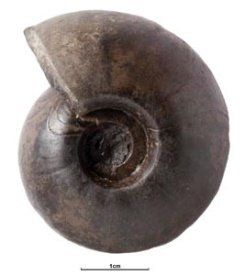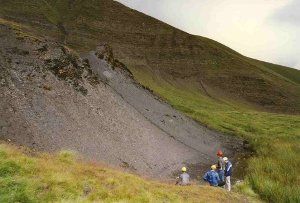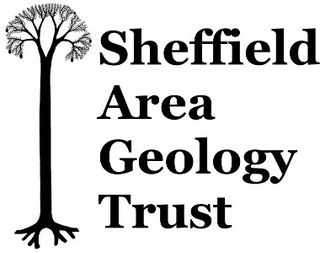Pendleian-Alportian
Recording, conserving and promoting the landscape and rocks of the Sheffield region
Pendleian /Alportian Substage

Fig. 1: Emstites leion
Scale bar 1cm (Photo: British Geological Survey. Creative Commons Attribution - NonCommercial-ShareAlike Licence)

Fig. 2: Edale Shales exposed at the foot of Mam Tor, with the Mam Tor Beds exposed in the cliffs behind
This is represented by the Bowland Shales elsewhere in Northern England, but the equivalent in the local region is traditionally known as the Edale Shales.
Edale Shales
(up to 250 m thick)
The base of the Edale Shales is marked by the band of marine fossils named after the goniatite Emstites leion
(formerly Cravenoceras leion), although in the Peak District the base is strongly unconformable on the underlying Visean limestones. The sequence consists of dark grey shales and mudstones with occasional bands of limestone, sandstone and nodules of ironstone. Fossils of goniatites and bivalves show that conditions were predominately marine, but the presence of fragments of carbonised driftwood shows that a distant forested land area was being eroded. The Edale
Shales provide the first evidence of the advance of the Pennine Delta from a generally northerly source. The Edale (Bowland) Shales buried at greater depths contain a potentially large resource of shale gas (methane).
email: sageologytrust@gmail.com
Copyright: Sheffield Area Geology Trust. Registered Charity No. 1133465, England
